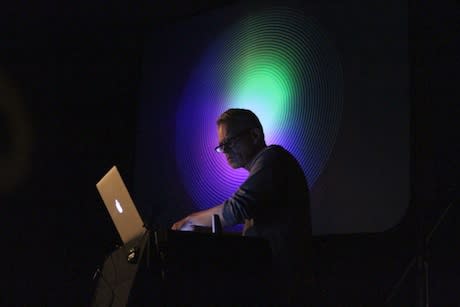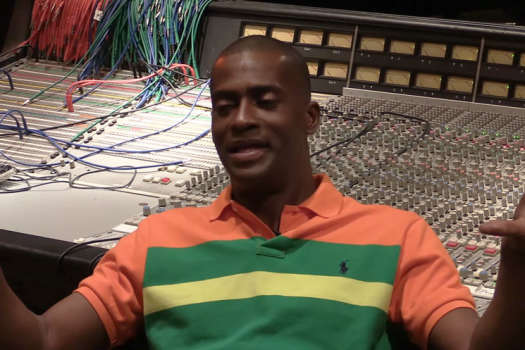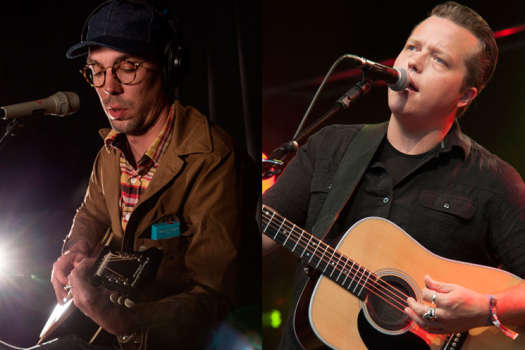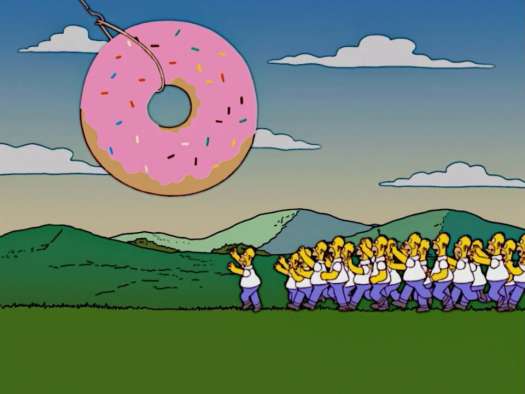As stated by Music Gallery director David Dacks in his introduction, tonight's performance from Frank Bretschneider was the North American premiere of the German experimental musician's Kippschwingungen piece, originally composed for and performed on the Subharchord, a unique electronic instrument designed in the 1960s intended for creating radio and TV special effects by RFZ (the audio-visual division of the East German postal service).
As Bretschneider explained at an artist talk earlier that day at the nearby Goethe-Institut, tonight he would be performing the piece on a laptop, manipulating stems of a performance he recorded using the Subharchord in Germany a few years prior, applying various filters and live-triggered visuals. The Subharchord itself weighs 100 kilograms and at this point is a rare museum piece too precious and heavy to transport outside of its native country.
The full capacity crowd at the Music Gallery was seated in silent anticipation as Bretschneider began his set. The faintest ambience could just about be discerned as a pink dot appeared on a screen, which had been positioned so that Bretschneider could work on the visuals in tandem with the music. The sound built as concentric circles began to appear like an animation of a virtual speaker cone, the circles reacting in real time to the music.
The teasingly slow build was punctured sporadically by a snapping beat, like a firework going off in the courtyard, and a stripped-down rhythm of barely audible bass grew slowly and organically. The sparse beat settled down into passages without any definite rhythm at all, replaced by bass drones that shared the same circular pattern and deep resonance of Tibetan singing bowls and resulting in a similar hypnotic and meditative power.
The visuals of blinding white light hiding a spectrum of colour, which held for the middle section of the show, was a perfect metaphor for the music that hid a multitude of tone beneath its seemingly atonal surface, much like a Rothko painting that needs the multitude of colour teased out of it by intense concentration and patience from the viewer.
As the set came to a climax, the circles of light morphed into a rainbow mosaic which, by that point, had the majority of the audience in a trance (except for one embarrassing dad trying a bit too hard and head banging in the back row). As the mosaic pattern collapsed back into white light and then further to a slowly dying green ember, the music stopped and the audience applauded, emerging from 45 minutes of collapsed time that felt equally like it could have been three seconds or 24 hours.
As Bretschneider explained at an artist talk earlier that day at the nearby Goethe-Institut, tonight he would be performing the piece on a laptop, manipulating stems of a performance he recorded using the Subharchord in Germany a few years prior, applying various filters and live-triggered visuals. The Subharchord itself weighs 100 kilograms and at this point is a rare museum piece too precious and heavy to transport outside of its native country.
The full capacity crowd at the Music Gallery was seated in silent anticipation as Bretschneider began his set. The faintest ambience could just about be discerned as a pink dot appeared on a screen, which had been positioned so that Bretschneider could work on the visuals in tandem with the music. The sound built as concentric circles began to appear like an animation of a virtual speaker cone, the circles reacting in real time to the music.
The teasingly slow build was punctured sporadically by a snapping beat, like a firework going off in the courtyard, and a stripped-down rhythm of barely audible bass grew slowly and organically. The sparse beat settled down into passages without any definite rhythm at all, replaced by bass drones that shared the same circular pattern and deep resonance of Tibetan singing bowls and resulting in a similar hypnotic and meditative power.
The visuals of blinding white light hiding a spectrum of colour, which held for the middle section of the show, was a perfect metaphor for the music that hid a multitude of tone beneath its seemingly atonal surface, much like a Rothko painting that needs the multitude of colour teased out of it by intense concentration and patience from the viewer.
As the set came to a climax, the circles of light morphed into a rainbow mosaic which, by that point, had the majority of the audience in a trance (except for one embarrassing dad trying a bit too hard and head banging in the back row). As the mosaic pattern collapsed back into white light and then further to a slowly dying green ember, the music stopped and the audience applauded, emerging from 45 minutes of collapsed time that felt equally like it could have been three seconds or 24 hours.




